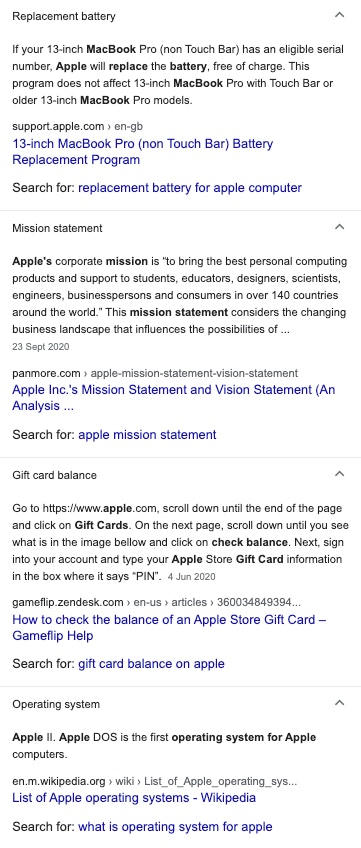We have combined the most significant Google algorithm and search industry updates from November and December 2020. As always, we have analysed their impact on websites and digital marketers alike. The traffic lights signal the impact and severity of each update.
In this blog post, we discuss:
- Google’s December 2020 Broad Core Algorithm Update
- Page Experience Ranking Signals for May 2021
- The return of the Request Indexing Tool in Google Search Console
- People Also Ask Boxes appearing in Brand Knowledge Panels
- Google Webmasters refresh
- Google Search Console releases new statistics
- The Structured Data testing tool to move to schema.org by April
December 2020 Core Update

On 3rd December 2020, Google announced the release of the December 2020 Core Update. Broad core algorithm updates usually take at least 1-2 weeks to roll out. This most recent update was complete on the 16th December.
The SEO community had been anticipating another broad core algorithm update for some time, with the last one occurring in May 2020. Whilst there was a 7-month gap this time , we would usually expect an update of this kind on a quarterly basis.
As with all of Google’s core updates, the December update focused on a wide range of different issues rather than one specific ranking factor, and sites in the YMYL sector experienced the most SERP volatility as a result.
In particular, last month’s update has brought about considerable fluctuation in verticals such as alternative medicine, online games, lyrics, and coupons, as well as big drops in visibility for some major ecommerce players like ASOS:

What does this mean for you?
First of all, don’t panic. It’s definitely worth checking your analytics to see if you’ve had any movement of organic traffic, but this update may have had little or no impact on your site’s organic visibility.
If you find that the December update has negatively affected your site, there’s lots you can do. As this was a core update, you can’t just focus on a single ranking factor when looking to recover – as Glenn Gabe puts it in his roundup article, “there’s never one smoking gun”.
A good start is to review Google’s core update guidelines and reassess your on-site content in light of the key questions listed there. Having begun your recovery with a focus on content, there are other technical and off-page considerations to take into account with a broad core update like this.
Check out Impression’s guide on How To Recover From A Google Algorithm Update to learn more.
Page Experience Ranking Signals Introduced in May 2021

In May 2020, Google announced that Page Experience signals would be included in search rankings. In November 2020, we learned that Page Experience signals will be considered a ranking factor from May 2021 onwards.
Page Experience signals include;
- Core Web Vitals
- Mobile-friendliness
- Safe-browsing
- HTTPS-security
- Intrusive interstitial guidelines
Page experience signals measure how users might interact with a web page and is part of Google’s ongoing aim to ensure their users get the most trustworthy, helpful and enjoyable experience when searching on the platform. In short, the new search ranking benchmark is being introduced to reward pages that offer better user experience and responsiveness in the SERPs. Whilst also encouraging sites to consider the above signals more seriously.
What does this mean for you?
Although the page experience update is not due to come into play for another 6-months, we would always recommend preparing for this. With Google giving us this much notice and knowing Google’s direction of creating a delightful user experience, it’s crucial to ensure your site is optimised technically and from an on-page perspective. We’d recommend avoiding intrusive pop-ups and full-screen banners that restrict the visitors’ access to the on-page content. Discover our guides to Core Web Vitals and how to comprehensively audit your on-page content.
Request Indexing Tool Returns to GSC

Much to the delight of SEOs around the world, Google reinstated the request indexing tool within Search Console. Google announced this on Twitter just before Christmas.
The tool was removed last year during October, whilst Google made some infrastructure changes. Webmasters were frustrated as they had been dealing with some ongoing indexing issues with Google and relied on this tool to resubmit URLs.
What does this mean for you?
You will once again be able to submit URLs using the request indexing tool. However, the Google Search Central team reminded users that this tool does not guarantee that the page will be indexed, and will only be included if it is “high quality, useful content”.
They also suggested submitting a sitemap, rather than requesting indexing, for large numbers of URLs.
PAAs now appear in brand knowledge panels

In December, we saw People Also Ask (PAA) boxes now appearing in brand knowledge panels. This is a significant change for any company that has a knowledge panel in the SERPs and is estimated to appear in 9% of brand knowledge panels since December. Meaning that content that has potentially not been written by the brand can gain control of your brand message.
In the below screenshot, you can see the drop-down menus in Apple’s brand knowledge panel for Replacement Battery, Mission Statement, Gift Card Balance and Operating System. Out of those four PAA boxes, only one of the answers comes from an Apple.com domain.


The content in Apple’s PAA boxes on their brand knowledge panel is not inflammatory or negative, but SEOs must be cautious of how this new feature could impact a brand facing controversy or negative reviews online. It will be better to err on the side of caution, especially if your brand has less than glowing PAAs in the search results.
What does this mean for you?
This is a significant change for any brand that has a knowledge panel in the SERPs. If you do, you need to start addressing the PAA queries about your brand within your content strategy as soon as possible.
You can find PAA queries and long-tail keywords on your brand by using AnswerThePublic or the Questions report in Ahrefs’ Keyword Explorer. Once you have conducted your keyword research, write optimised content that directly answers the question and includes the question. Then decide whether it has the search potential for a new blog/page in itself or should be embedded on an existing informational page.
Google to move the Structured Data testing tool to schema.org by April

When Google announced that they would be retiring the structured data testing tool back in July 2020, they were met with considerable backlash from SEOs.
Google Search Central has since told webmasters that they have heard the feedback and will be repurposing the tool in future.
What does this mean for you?
Moving forward, the tool will be migrated to a new domain which serves the schema.org community. This is set to roll out in April 2021. The tool will be to “check syntax and compliance of markup with schema.org standards”, however, you will no longer be able to check for Google Search rich result types. Instead, you should use the existing Rich Results Test.
Google Webmasters Refresh

Google announced on November 11 that Google Webmasters would be renamed Google Search Central. The decision for the name change came from a user experience study Google ran which found that very few people referred to themselves as Webmasters, preferring SEO, online bloggers or site owners.
The goal of the platform will remain the same; to help people improve their visibility on Google search. Google also said that they would be centralising their documentation on how Google Search works and general search guidelines now being found on the new site.
What does this mean for you?
This change will make it easier for people to find the information they need. Nearly all relevant documentation to Google Search will now be available on Google Search Central, while information relevant to Google Search Console will be available at the Search Console Help Centre.
Google Search Console Releases New Statistics

On November 24th, Google announced the availability of new crawl statistics in Google Search Console. The new data allows site owners how many crawl requests on the site grouped by response codes, crawled file type, crawl purpose, and Googlebot type. Site owners will also be able to delve into host status issues and spot any worrying trends before widespread crawling issues occur.

What does this mean for you?
The new statistics will be useful for anyone wanting to learn more about how Google crawls their site. The data will help identify any crawl issues on a subfolder or file type basis and help SEOs make more informed decisions to developers.
Has your website been affected by any of November or December’s search industry updates? Learn more about our SEO team’s penalty and broad core algorithm recovery services today.




